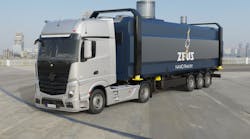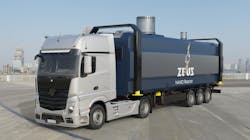Chemical Processing Notebook: Will Mini Nuclear Plants Power the Chemical Industry's Future?
For the chemical sector, managing greenhouse gas emissions has focused on renewables, carbon capture technologies and more energy-efficient processes. There’s a wild card, though, that receives much less attention. Nuclear energy is seen by many in the industry as a promising development that can provide a consistent supply of clean energy. Unlike renewables, which encounter intermittency issues, nuclear can provide a sustained level of power.
“As the share of intermittent renewable energy systems—mostly solar and wind—increases in power grids, more flexible power generation is needed,” Denis Janin, energy economist at PreussenElektra, said in an article on the International Atomic Energy Agency website. “This can take several forms: hydropower, gas-fired power plants, advanced batteries, or nuclear power. In France and Germany, nuclear power load following has been a reality for many years already.”
For industry, nuclear doesn’t necessarily mean sprawling power plants with hulking cooling towers. Instead, these companies are exploring the use of modular reactors located on site to power their operations. I first learned about the potential use of nuclear in chemical processing operations while attending the World Chemical Forum in Houston back in September.
As the article stated, Dow is looking to have an operational nuclear plant supplying power to its Seadrift, Texas, location by the end of the decade, said Kreshka Young, the company’s North America Business director for energy and climate, during the forum.
As a follow-up on the topic, I recently spoke with James Walker, CEO at Nano Nuclear. Walker’s company is developing small nuclear reactors that can be deployed to remote mining sites and oil and gas projects.
James, my understanding is that your company develops small nuclear reactors that can be deployed at industrial sites and connected to the power grid. Is that correct?That’s a pretty good assessment. We are not an SMR (small modular reactor) company that will feed into cities or towns. When we were looking at the market, we believed that the more interesting and larger market was to be found at the very small end of the power delivery industry. So we're talking about mining projects, remote oil and gas, remote habitation, perhaps replacing bunker fuel on shipping vessels, charging stations for EVs, disaster relief areas, even data centers and obviously industrial projects, such as chemical facilities.
When I think about nuclear energy, I envision these sprawling power stations with big cooling towers. Can you talk a little bit about how your technology is different in terms of the amount of power generated and the overall footprint?
Yeah, so those big civil nuclear power stations, they can be expected to be about a gigawatt of energy. They're incredibly powerful, and their footprint can be 50, 60 city blocks. There was a change in attitude towards nuclear that came about in the SMR space, the small modular reactor. And that was principally so you could almost fabricate a lot of reactors simultaneously and deploy them much more easily with a smaller footprint. And that also came about because when you have one of those big civil power plants, 60% or 70% of the costs of that might be financing related. And so, if you want to reduce that and have cheaper energy coming from nuclear, then SMRs are the way to do it. An SMR is somewhere between about 20 megawatts to about 300 megawatts.
What we do is a micro reactor – anything beneath 20 megawatts. And the footprint of those is even smaller. For an SMR, you're looking at 10 city blocks. For a micro reactor, the ones that we are doing, is the ISO (intermodal container) container size. The core, the heat exchangers, the electrical outputs, that all takes place within one ISO container. So, the footprint is going to be incredibly small for these. We're essentially wanting to just ship them in and put them down, plug it into the local microgrid. and that'll be it.
So how far away are you from actual deployment of your technology at this point?
We still believe we're going to be the first micro reactor company to deploy a licensed micro reactor ready for industry and customers. We've moved through the preconceptual design into the conceptual design, and now we're moving into physical test work. We’ll be doing demonstration work to get the data necessary to go through the licensing process, which is expected to begin in about 2026 and be about a three- to four-year process. So, we'll have a reactor ready to go as early as 2030, where we'll have that reactor hopefully ready to deploy, but in also sizeable numbers – so 10, 20, 30 reactors ready to go out the door.
What are the advantages for a chemical manufacturer? Why nuclear over renewables like wind or solar to meet their emission reduction targets?
Interestingly enough, when the founders of the company were actually looking to start, they were very soberly examining the energy landscape, and they did consider investing in wind and solar as part of the company. But what they realized very quickly is that they must have optimum conditions for wind and sun. That might eliminate large tracts of land where you can't really get a sufficient amount of wind and solar to meet your purposes. And then the next thing they realized is that for industry, the capacity factor – so the consistency of those energies – was actually very low. I think for solar you're looking at about a 15% capacity factor, and I think wind is about 20%, but nuclear is over 90% capacity factor. So it's the most consistent power.
And the next problem with (wind, solar) was that it needs an enormous tract of land. It could even be argued that you could increase your carbon footprint by having to utilize so much land. So there are enormous challenges with wind and solar. I don't think there's any perfect solution to energy requirements, but for industry it looks like nuclear is going to be far better suited because it can be placed anywhere, it's consistent, and the footprint can be much smaller.
What about cost? What type of investment is a manufacturer like a chemical company looking at if they want to deploy nuclear?
I don't think anybody has a good idea about that at the moment, but obviously we brought in our own financial modelers that have begun to look at the cost that would be associated with leasing or purchasing reactors. The first reactor will be expensive, and after that they're going to get cheaper and cheaper. We estimate actually within the first 10 years of operation, the capital costs of the reactors are going to come down by about 70 to 80%. And that's not just our own internal calculation. University of Texas and Idaho National Laboratories have conducted their own independent assessments and found similar (results). So, given time, once nuclear has begun to be deployed more widely, the energy costs of it are going to come down to make it the cheapest energy form that there is. And currently, the reason why nuclear is seen as expensive is those high financing costs are related to the big civil power plants. And two, the industry has not been optimized. While I'm obviously reticent to give exact numbers, if you are working with, say, a $50 million initial cost of a micro actor, I would still expect that to come down by 70 or 80% over the next 10 years of the company's initial deployment.
How safe is the technology?
Well, I mean nuclear is held to a higher safety standard already than any other energy type. If you look at deaths per gigawatt hour, it's the safest of all energies, actually. It beats out wind and solar in terms of safety, in terms of the number of deaths the energy is responsible for as it relates to output. So already, nuclear is very safe. Once you start shrinking a reactor down, it actually gets safer. So, if you go from civil power reactors down to SMRs, it's already safer. And the reason for that is the number of mechanisms that can go wrong decreases; there's less nuclear material. If every single component within our reactor was to break simultaneously, it would just passively cool. And the advantage to that is that the most critical disaster you could get with a civil power reactor is a coolant leak resulting in core melt.
Can you describe what these reactors look like if they’re being deployed to a chemical plant, for instance?
With a chemical plant, obviously, it's got its own sort of microgrid. There would need to be just a general assessment about how close we could have the reactor to certain facilities like the microgrid at the plant. You would need to consider things like seismic activity or, say, risk of damage from anything that was to occur at the plant itself, heat conditions, as well as flooding risk – anything like that that would determine how close you could actually move the reactor to the microgrid itself. But really, once it's there, there's nothing wrong with just a small fence around the reactor perimeter; (then) the ISO container goes down. There are no real limits on how close it can be to that system. If it needs to be sited further away, then you would just site it further away and run the cable straight to the microgrid for the chemical plant.
Running a chemical plant is already fairly complex. If an operator now has a nuclear facility on site, doesn't that create a whole new set of challenges?
That’s obviously something we've had to consider because we don't want our customers to have to become experts in the operation of a nuclear plant. So, it's very likely when we deploy the plant that we'll continue to run it for them and provide the energy. And one very likely business model that will result from that is that we will lease the reactor to the company, and they just pay us for energy usage or an annual lease. That builds into consideration how much energy they're getting out of the reactor, but it's very likely we'll end up running the reactor for them.
Can you talk a little bit about the role nuclear energy could potentially play in the development of green or clean hydrogen?
This has come up quite a bit because the great thing about nuclear reactors is they produce heat, and the more heat you produce the better it is for hydrogen production. So you have some options here. It's very unlikely for any industrial process or remote habitation or military base or mining project that you're going to need a constant maximum output from the reactor. So what do you do with the reactor when it's not producing electricity for your processes? You could still run the reactor, and instead of converting to electricity, use that heat to produce hydrogen. And you could even purchase one of these reactors straight up just to produce hydrogen because the heat generated makes it a way more efficient process. And this is probably one of the most difficult things, I suppose, for hydrogen manufacturers is achieving that heat in a way that's a net energy benefit.
What other challenges need to be addressed to make nuclear energy a reality for industrial customers?
I think the biggest challenge for micro to deploy on a commercial basis, it's not the technology so much, and it's not the expertise. The licensing, the regulatory process for nuclear is more stringent than any other energy or any industrial or manufacturing process. I think in the world there needs to be a slight adjustment to the way licensing is done for these smaller reactors so they can be deployed a bit more easily. Also, amending the framework to show that the micro reactor should be permitted to deploy to any location provided it meets certain safety criteria like seismic flooding temperature. As long as it factors into consideration those safety considerations, it should be deployable to those areas without a separate site-licensing process. I think that would enormously assist in the proliferation of a lot of micro reactors very quickly to these locations because you can't really evaluate it in the same way that you would evaluate a big civil nuclear plant. They are almost different industries, almost different technologies, and I think the regulatory framework just needs to be adapted to reflect that new industry that's arisen out of nuclear.





